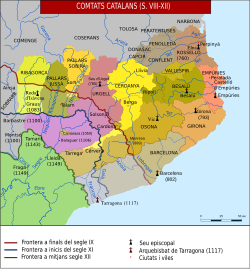County of Roussillon
| County of Roussillon | ||||||||||
| Comtat de Rosselló (Catalan) | ||||||||||
|
||||||||||
|
||||||||||
|
The County of Roussillon and other Catalan counties
|
||||||||||
| Capital | Perpignan | |||||||||
| Religion | Roman Catholic | |||||||||
| Government | County | |||||||||
| Historical era | Middle Ages | |||||||||
| • | Establishment | 759 | ||||||||
| • | Annexed into the Principality of Catalonia | 1172 | ||||||||
|
||||||||||
| Today part of |
|
|||||||||
The County of Roussillon (Catalan: Comtat de Rosselló, IPA: [kumˈtad də rusəˈʎo], Latin: Comitatus Ruscinonensis) was one of the Catalan counties in the Marca Hispanica during the Middle Ages. The rulers of the county were the Counts of Roussillon, whose interests lay both north and south of the Pyrenees.
There was a Visigothic county around the city of Ruscino in the 6th and 7th centuries with a jurisdiction corresponding to the Diocese of Elna. This primitive county comprising the historic comarques of Plana del Roselló, Conflent, and Vallespir was created by Liuva I in 571. The Visigothic legacy in Roussillon survived in its courts, where Visigothic law was applied exclusively as late as the 11th century.
Roussillon was occupied by the Moors in 721. It was probably conquered for the Frankish Empire by Pepin the Short and his Visigothic allies in 760, immediately following his conquest of Narbonne, though all that is certain is that it was in Frankish hands during the reign of Charlemagne. Roussillon had been nearly completely depopulated, was not widely cultivated, and land use was very inefficient, which has often been explained by Moorish razzias and Frankish reprisals over a span of forty years.
...
Wikipedia



